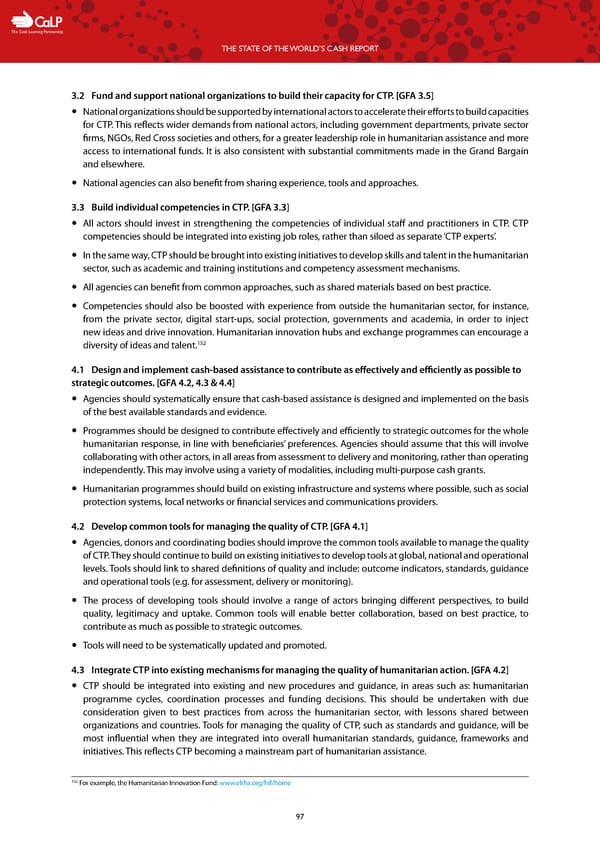C The Cash Learning Partnership THE STATE OF THE WORLD’S CASH REPORT 3.2 F und and support national organizations to build their capacity for CTP. [GFA 3.5] — National organizations should be supported by international actors to accelerate their efforts to build capacities for CTP. This reflects wider demands from national actors, including government departments, private sector firms, NGOs, Red Cross societies and others, for a greater leadership role in humanitarian assistance and more access to international funds. It is also consistent with substantial commitments made in the Grand Bargain and elsewhere. — National agencies can also benefit from sharing experience, tools and approaches. 3.3 Build individual competencies in CTP. [GFA 3.3] — All actors should invest in strengthening the competencies of individual staff and practitioners in CTP. CTP competencies should be integrated into existing job roles, rather than siloed as separate ‘CTP experts’. — In the same way, CTP should be brought into existing initiatives to develop skills and talent in the humanitarian sector, such as academic and training institutions and competency assessment mechanisms. — All agencies can benefit from common approaches, such as shared materials based on best practice. — Competencies should also be boosted with experience from outside the humanitarian sector, for instance, from the private sector, digital start-ups, social protection, governments and academia, in order to inject new ideas and drive innovation. Humanitarian innovation hubs and exchange programmes can encourage a 152 diversity of ideas and talent. 4.1 Design and implement cash-based assistance to contribute as effectively and efficiently as possible to strategic outcomes. [GFA 4.2, 4.3 & 4.4] — Agencies should systematically ensure that cash-based assistance is designed and implemented on the basis of the best available standards and evidence. — Programmes should be designed to contribute effectively and efficiently to strategic outcomes for the whole humanitarian response, in line with beneficiaries’ preferences. Agencies should assume that this will involve collaborating with other actors, in all areas from assessment to delivery and monitoring, rather than operating independently. This may involve using a variety of modalities, including multi-purpose cash grants. — Humanitarian programmes should build on existing infrastructure and systems where possible, such as social protection systems, local networks or financial services and communications providers. 4.2 Develop common tools for managing the quality of CTP. [GFA 4.1] — Agencies, donors and coordinating bodies should improve the common tools available to manage the quality of CTP. They should continue to build on existing initiatives to develop tools at global, national and operational levels. Tools should link to shared definitions of quality and include: outcome indicators, standards, guidance and operational tools (e.g. for assessment, delivery or monitoring). — The process of developing tools should involve a range of actors bringing different perspectives, to build quality, legitimacy and uptake. Common tools will enable better collaboration, based on best practice, to contribute as much as possible to strategic outcomes. — Tools will need to be systematically updated and promoted. 4.3 I ntegrate CTP into existing mechanisms for managing the quality of humanitarian action. [GFA 4.2] — CTP should be integrated into existing and new procedures and guidance, in areas such as: humanitarian programme cycles, coordination processes and funding decisions. This should be undertaken with due consideration given to best practices from across the humanitarian sector, with lessons shared between organizations and countries. Tools for managing the quality of CTP, such as standards and guidance, will be most influential when they are integrated into overall humanitarian standards, guidance, frameworks and initiatives. This reflects CTP becoming a mainstream part of humanitarian assistance. 152 For example, the Humanitarian Innovation Fund: www.elrha.org/hif/home 97
 The State of the World's Cash | Full Report Page 98 Page 100
The State of the World's Cash | Full Report Page 98 Page 100